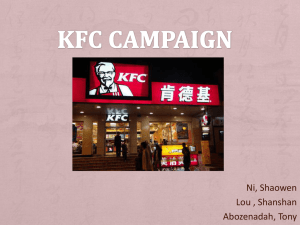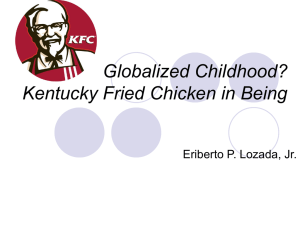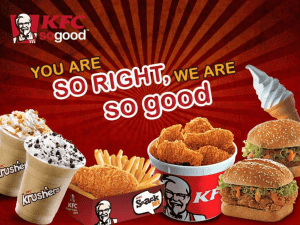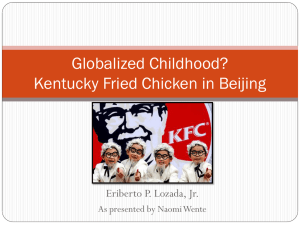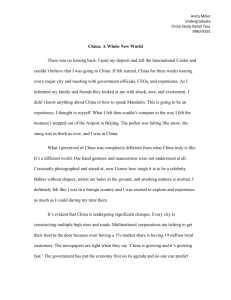Rice or Fried Chicken?
advertisement
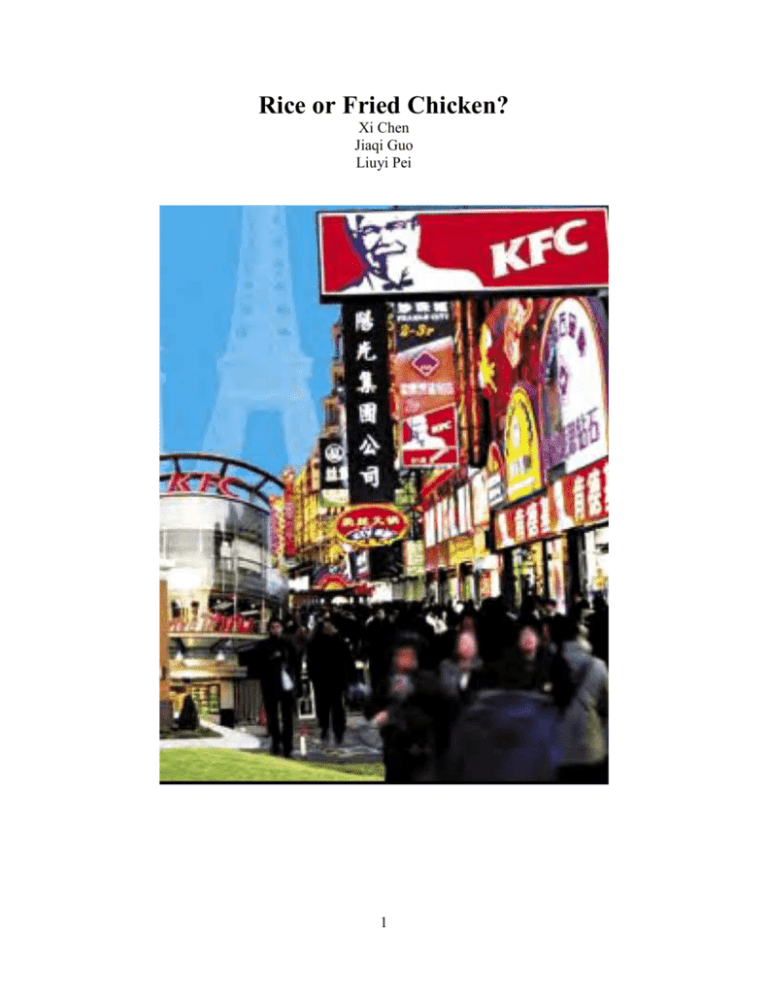
Rice or Fried Chicken? Xi Chen Jiaqi Guo Liuyi Pei 1 Table of Contents Introduction 3 Background Information 3 Analysis of KFC’s Success in China 3 Porter’s Six Forces Analysis Entry Buyer/Supplier Bargaining Powers Substitutes and Complements Rivalry 4 5 5 6 Competitive Analysis Customer Identification and Customer Base Product Range Marketing Strategy Branding Appealing to the Younger Customers Organization 6 6 7 7 7 KFC’s Testing Strategies 8 Strategies for the Future Marketing Localization Localization of Food Localization with Respect to Life Style Employing Value/Cost Strategies Expanding Geographically Price Discrimination 9 9 10 11 11 12 12 Conclusion 13 References 13 Appendix A 15 2 Introduction Within the fast food industry, KFC has always been second to McDonald’s both in terms of the number of branches that it has in various countries and its total sales and profits. In the United States, the sales performance of McDonald’s summed up to over twenty billion US dollars in 2003, whereas KFC’s only total slightly over five billion1-2. Strangely, it is in China, one of the more conservative and traditional countries, that we find KFC overwhelming McDonald’s as the most popular and the most profitable fast food restaurant. Having both developed fourteen years in China, KFC had 1200 restaurants nationwide and a sales volume of 9.3 billion US dollars in 2004, while McDonald’s only opened 600 restaurants and had a miserable sales volume of 5.3 billion1-2. It is not surprising that with increased globalization and westernization of Asian countries, fast food restaurants have found their way into such a juicy market as the rapidly expanding China, but it is surprising that KFC should have had obtained a stronger foothold than McDonald’s in the infusion of Western culture into China. Thus, our paper will examine the factors that resulted in KFC’s success in China, analyze the market situation KFC is currently in using Porter’s Five Forces, competitive analysis and by comparison with similar markets such as Singapore and Hong Kong, and lastly, propose strategies that KFC should adopt to maintain its number one position in China. Background Information Boasting a secret recipe of numerous spices and “finger licking good” chicken meals, KFC was started by Harland Sanders as a tiny restaurant – called “Sander’s Court and Café” – at a gas station3. Now, managing more than 11000 restaurants in 85 countries, KFC is the world’s largest chicken fast-food restaurant and one of the top fast-food chains worldwide. It was also one of the first fast food restaurants to go international4 and is popular in many countries. After having gone through many different hands, KFC is now under Yum! Brands, Inc., with A&W All-American Food Restaurants, Long John Silvers, Pizza Hut and Taco Bell3. It is primarily operating in the United States (domestic market) and is focused on developing chains in some rapidly expanding and thus financially appealing countries (international market) such as Canada, Australia, China, and Mexico4. Analysis of KFC’s Success in China China is home to 1.2 billion people, one fifth of the world’s total population, and within the past few decades, China has been eagerly taking in and experimenting with as many western products and ideas as it can digest, including technology, entertainment, and of course, dining. KFC was smart enough to seize this opportunity before any other fastfood restaurants, and therefore has the advantage of being the first of its kind in this new 3 market. As early as 1985, KFC already had its eyes on this market.5 After a great deal of research, the first KFC restaurant opened in Beijing in 1987. It was the first western style fast food restaurant in mainland China, and benefited from a free reputation and no similar competitors for customers. Less than 10 years later, KFC managed to open 100 restaurants throughout China. By the end of 2004, KFC stores has reached 1200, double the number of its primary competitor, McDonald’s.1 Other than the first mover advantage, KFC, as the restaurant that introduces fast food to the Chinese market, also held the advantage of novelty over other traditional Chinese restaurants. They present the revolutionary idea of western quick-dining, and has a specialized menu focused extensively on chicken. Compared to a home-cooked meal where a lot of smoke and oil is involved as well as a large pile of dirty pots, pans, and dishes, dining at KFC, with its quick service and disposable eating utensils, is much more relaxed. In fact, the Chinese were so attracted to this type of dining that some people even held weddings at KFC6. In addition, KFC’s target customers are also different from those of traditional Chinese restaurants. Rather than targeting families and adults, they look for teenagers who are accepting of new cultures and ideas. They give numerous discounts to high school and college students, hoping to acquire such a group of young adults with a lot of money from their parents to spend as their primary customers. McDonald’s, on the other hand, focuses primarily on children and young parents, spending a lot of money in building playgrounds within the restaurants for kids and giving out toys with kids’ meals, using the same strategy as it does in the U.S. The aims of KFC and other fast food restaurants are different; therefore, it reduces threats to KFC posed by other competitors. Another advantage that is often overlooked lies in the products of the restaurant itself. Chicken in general suits the Chinese taste more so than beef, and even though teenagers may be attracted to hamburgers and fries, families as a whole have tastes that lean more towards the taste of KFC. 7 Other than advantages KFC has over other restaurants of similar and/or different styles, it also has high standards that guarantee service, quality, and reliability to its customers. The acronym CHAMPS, which stands for “cleanliness,” “hospitality,” “accuracy,” “maintenance,” “product quality,” and “speed,” are the goals that KFC aims to accomplish. KFC’s employees, both management and storefront, must undergo strict training and pass inspections in order to actually work for the restaurants, and the management level holds impromptu employee activities to facilitate store-to-store communication and relations, and where they could learn from each other, therefore improving overall quality. 7 Not only do these establish a good reputation with KFC customers, they also set a standard in the eyes of the Chinese population that competitors of similar characteristics are expected to reach. 4 Porter’s Six-Forces Analysis Entry For the current Chinese market for fast food, it is not difficult for a fast-food restaurant to enter the market. However, it would be extremely difficult to take over KFC’s dominancy in China or even make a significant amount of profit. While there are enough people in urban China for any restaurant to survive, KFC holds the first-mover advantage that gives them free reputation. Customers, especially children who are used to going to KFC as a treat or reward from their parents or grandparents, are not going to want to go to other restaurants they’ve never heard of. The brand name is already established. Also, there is already a large variety in the numerous western-style dining places in China, such as McDonald’s, Pizza Hut, and Subway, and any new fast-food entrants would just be presenting something very similar to what’s already there. While small neighborhood restaurants generally have low barriers to entry, these are the barriers to entry for similar restaurant businesses to enter the fast-food chain market. Buyer/Supplier Bargaining Power The customers of KFC, especially as individual buyers, have almost no bargaining power because if only one customer threatens to no longer eat at KFC, the store is not going to lower its price because the cost of losing one customer is not very great. The suppliers, like the buyers, have very little bargaining power. In terms of food, KFC, upon its move into China, urged many of its U.S. suppliers to also extend branches into China. KFC also began helping local suppliers by giving them technological support to improve their products. This is a brilliant strategy because the supplies that KFC would otherwise need to import from the U.S. can now be obtained domestically, and if the U.S. suppliers decide to raise their prices, KFC can easily switch to the local suppliers. With this strategy, KFC created competition among its suppliers, lowering the supplier bargaining power.8 In terms of human resources, labor cost is extremely low because the supply of non-skilled workers great exceeds the demand for them. With so little buyer and supplier bargaining powers, KFC is able to have a very tight control over its prices and expenditures. Substitutes and Complements As mentioned above, there are a few major competitors in the fast-food industry in China for KFC, namely McDonald’s, Pizza Hut, and Subway. The substitute products, in this case, would be burgers, pizza, and sandwiches. Though they are competitors, their primary products differ greatly from each other, in that they sell, chicken, burgers and fries, pizzas, and sandwiches, respectively. Traditional Chinese dining, home-cooked meals, and grocery stores with ready-to-eat foods 5 are also substitutes, as families could choose any one of these over fast food for a meal. Even foods from street vendors count as substitute goods. While other fast-foods serve as substitute to KFC, they can also serve as complements for fast-foods as a whole. If the general price of fast foods go up, KFC’s price rises as well, and the same can be said of the quantity sold of these products, which make them complements to each other. KFC also sets up stores located near popular tourist attractions9, so tickets to these tourist spots are also complementary goods because the more people tour these attractions, the more customers KFC will get. Rivalry Unlike what one would expect, KFC has little rivalry with similar fast-food chains in China. The primary reason is that their core products are different, as in they sell different kinds of fast-foods with very different tastes and styles. For example, if KFC raised its price for chicken by a small amount, Chinese chicken lovers who may not be as accepting to pizzas (many Chinese people strongly dislike the taste of cheese) are not going to switch to Pizza Hut just because the price for KFC increased. In addition to that, these restaurants have such different target customers that the fluctuation of price for one restaurant is not going to affect the others. For example, a full meal at KFC range about ¥15, whereas a full meal at Pizza Hut can cost over ¥50. The drastic difference in price assures no price competition between these restaurants. Competitive Analysis Customer Identification and Customer Base The primary customers of KFC in the Chinese market are teenagers and young families in urban China. In terms of the size of this customer base, we can use Beijing as an example. Those in the age group 0-14 in Beijing add up to about 1.878 million, or about 13.6% of the total city population.10 Other major cities in China, such as Shanghai and Tianjin, have similar population structures. In urban cities, the average per capita food expenditure in the year 2004 is about ¥2,700 and it has been growing consistently for the past decade.11 It is likely to continue increasing judging from the trend (see Graph 1 in Appendix A). McDonald’s and other fast food restaurants have very similar target customers and customer base. Product range The product range of KFC spans over all meals: breakfast, lunch, and dinner, as well as snack foods. The main products of KFC includes chicken, potato products 6 such as mashed potatoes and fries, corn, vegetables (salads), and deserts. KFC also offers certain items on their menu that are tailored to the local taste, such as rice porridge and chicken wraps that resemble the style of Peking Duck12. McDonald’s has a slightly different product range. Its major selling product is beef13. Other than that, its products are generally similar to those of KFC and it serves breakfast meals, as well. Pizza Hut and Subway mostly specialize in pizzas and sandwiches respectively, and they do not serve breakfast like KFC and McDonald’s. Marketing Strategy Branding Currently, KFC has a marketing strategy that focuses mostly on its food. Its slogan is “Finger-licking good” and it lacks tie-ins with what is current and popular in the teenage society, and does not seize things already accepted as popular as their marketing tools. Outside of advertising, KFC offers financial help to students in need by giving out scholarship funds. In addition, KFC has an internet club called “Home of Internet Friends,” which promotes some social activities such as the most recent “Who is most like Colonel Sanders” and give electronic discount coupons to its members.12 Besides these, we feel that KFC has not done enough for its own branding that will appeal to a larger Chinese population. McDonald’s, on the other hand, ties its products closely with what’s really popular at the time. Its slogan, “I’m Lovin’ It,” incorporates more than just food, but everything else. It hired very popular Chinese and American singers, such as Wang Lee Hom and Destiny’s Child, that do advertisements for them and provide appealing images for its brand.13 McDonald’s also tries to make itself more personal to the customers by offering an “open-door” event on a daily basis, where the kitchen is open to the public and the customers can ask the employees about the products on the menus.14 Appealing to the Younger Customers KFC always incorporates toys with their Kid Combo, family combo and other promotional foods. KFC makes toys that are popular in China – such as Doraemon or Detective Conan – rather than Hello Kitty or Superman, which are popular elsewhere. These toys play a non-trivial part in promoting KFC. When parents take their children out for a meal, children are more inclined to pick KFC because they can not only get the 7 food they like, but also toys that appeal to them. When children bring the toys to their playmates, they are unconsciously helping to advertise KFC. McDonald’s also sells similar toys, aiming to attract younger customers. Organization KFC’s main strategy is to expand very quickly in China and locate itself close to either residential areas or popular tourist attractions. It is currently expanding at the rate of 300 new restaurants a year15. This makes the restaurants extremely accessible to customers. However, at this stage, customers can dine in the restaurant or take out their meals, with drive-through services only offered at four restaurants16. On the other hand, McDonald’s is less worried about expansion, and is planning to increase its number of restaurants by about 100 a year, resulting in 1000 restaurants by the start of the Beijing Olympics16-17. McDonald’s hopes to overtake KFC by offering drive-through services at most of its restaurants to increase convenience for its customers16. We feel that this strategy may not work in China as land is limited in China, especially in the major cities, and infrastructure will likely not be able to keep up with services. This may result in many restaurants with drive-through areas that are difficult to access. Therefore, in response, KFC does not need to worry much about this. KFC’s Testing Strategies KFC did not enter the Chinese market without testing the waters. It actually opened stores in Hong Kong long before doing so in mainland China. The business did not succeed for several reasons. First, the Hong Kong population was already very westernized, so it did not find KFC to be very appealing based on novelty. Also, Hong Kong dining is very high quality, and things such as dim sum are practically incorporated into the family tradition. It is very difficult for a fast food to cut into this tradition without the offer of novelty. In addition, Hong Kong people did not find KFC’s eating utensils very environmentally friendly. When the business did not succeed, KFC switched testing locations and moved its primary focus to Singapore, where chicken, particularly deep-fried chicken and Hainanese chicken rice, is very popular in itself18-19. KFC also launched the “Chicky Club,” which is a group that organizes events for children who would otherwise find it difficult to participate in such events. For example, if a popular band toured Singapore, the Chicky Club would help facilitate interactions with the band for kids by distributing lower price tickets or even organizing a separating event for members of the Club. Chicky Club would also publish a monthly magazine with comic strips and competitions for small children, such as coloring activities and puzzles20. This Club met with wide success in Singapore. 8 In addition to the Chicky Club, KFCs in Singapore also offers deliveries during the days the World Cup airs on television21. To cater to the lower-income customers, KFC also offers snack foods such as wraps and fries for very cheap prices22. Both of these strategies also met with success in Singapore, making KFC one of the largest fast food restaurants in Singapore. Strategies for the Future Having tested the business strategies in Hong Kong and Singapore, KFC should realize the best strategic plan and put it to use in the biggest market of them all: China. Judging from the competitive analysis and the success/failure of KFC in Singapore/Hong Kong, we propose that KFC’s strategy should include two main thrusts: to improve its marketing strategy, and to continue its localization effort both in terms of food and lifestyle. In addition, KFC should reach out to more customers and continue practicing its value/cost strategy, expand geographically to maximize profit and could also consider exercising price discrimination. Marketing With the success of the Chicky Club in Singapore, KFC should employ similar strategies to the Chinese market. The internet club already exists and is relatively successful, but because not everyone has access to the internet, KFC should also form an organization off the internet that host social events for membershipholders only. KFC should charge customers a small fee for membership into this club, and those who become members will have access to the social events KFC would host. Examples of such social events include concerts with famous bands, meetings with famous actors, and less specialized events like distributing movie tickets and theme park tickets at low prices. To promote more spending at KFC, the company should incorporate different levels of membership within the organization and give different privileges to reward frequent customers, like the way airlines give frequent flyer miles to customers who travel a lot. For example, they could make discounts on tickets to the most popular and/or most rare events available only to premium members of the organization and the more common benefits, such as cheap theme park tickets, accessible to all members. KFC could employ a point system, where customers require a certain number of points to rise to the next level of membership, and these points would be distributed in proportion with how much money the member spends. There must a limit to the rise in membership status, and thus, KFC should put an age limit for the members of this organization. Originally, these social events are aimed at target consumers up to teen-age, so the age cap should be put at 18. Once a customer is past this age, he/she is automatically no longer a member of the organization. 9 With this organization membership tactic, customers who want to rise in membership status and gain access to the most benefits from the KFC organization must give KFC a lot of business. Not only will customers spend more for the prospective benefits, rising in status is an incentive in itself to spend more. In addition, KFC will be able to associate itself always with what is new and popular in the teenage, as well as create many complementary goods to its products, such as concert tickets and amusement park tickets. Localization Localization of Food With a market such as China with a longstanding tradition, KFC executes must realize that they are faced with customers very different from the rest of the world. It cannot distribute the exact same products there as it does in every other part of the world. As they are faced with different markets, KFC must learn to adjust its products accordingly. The key is to localize the products, or try to make them more suitable for the local taste, style, and tradition. First and foremost, KFC should adjust its menus to fit the Asian taste. “Several items can be found on KFC's menu that are specifically tailored for Chinese market, including congee (rice porridge) and a soup made of spinach, egg and tomato.”10 Last year, KFC created an item called the "Old Beijing Twister,” a wrap modeled after the way Peking duck is served, but with fried chicken, spring onions and hoisin sauce.10 These are the kind of adjustments that would make KFC’s more preferable for the average Chinese customer than those of McDonald’s or Pizza Hut, as suggested by the observation that McDonald's and KFC restaurants were almost empty during the traditional celebrations of Spring Festival and Mid-autumn Festival, while Chinese restaurants were heaved and bustled23. KFC should also think about its middle-aged customers. One concern that most older Chinese customers (above teen-age) have regarding KFC food is the healthiness of fried products. KFC should add more items to the menu that are less oily and more health-focused, such as less oily foods and more vegetables. This way, not only will KFC be able to expand its customer base to include middle-age customers, but will also be able to keep up with the change in preferences as its current customers grow older. In addition to the previous two kinds of item additions to their menu, KFC should also update their menu periodically to keep the tastes fresh and new products available. Changes in substance do not necessarily have to be very big, but changes in name should be very much advertised. Customers will get tired of the same products, so changes in the otherwise routine 10 foods will always be popular. The tag “New!” on most products also provides a good motive for customers to purchase it with the reason “We’ll just try it this one time.” To make additions to the menu list easier and safer, we propose a 1-month promotional period for every new product put on the market. During this period, the product will be advertised at a price slightly lower than KFC standards. After a month of putting it on the market, KFC will be able to see how the product is received and act accordingly. If it met with wide popularity, then KFC should keep it on the menu and raise its price to match the KFC norm, whereas if it did not receive general approval, KFC should still keep it on the menu but only for a short period of time, like two more months, and take it off the menu after that time period. This way, it would be very easy to see what fits the popular taste and what does not. Localization with Respect to Lifestyle In learning its lesson from Hong Kong’s failure, KFC should also remember to cater to the local market in terms of lifestyle, and not just taste. As KFC branches are mostly located in urbanized areas, many of the families that are being served are double income families, and would usually not have the time to cook. Providing a delivery service for these families would increase the convenience of getting dinner for these families, and customers will be more inclined to patronize KFC. In Singapore, KFC adopted a brilliant strategy of offering late-night delivery services during the World Cup season, as they foresaw that many soccer fanatics would stay up to watch the games and would thus welcome a hot meal. Like Singapore, many people in China are dedicated soccergames followers, and it would be profitable for KFC to once again satisfy the needs of its customers and offer special delivery services during special occasions. Employing Value/Cost Strategies KFC already dominates the Western fast-food market in China, and to maintain this position, it should continue its cost minimization strategy for a moderate level of value, as Porter suggests24, if only as a company competing for its proper market share in the industry. This would enable KFC to keep its pricing flexible and allows it to maximize its profit. So far, KFC has been applying the “mass-market strategy”24 has been to minimize the costs for a moderate level of value, which is affordable and appeals to most of the people in urban China. Compared to the cost of dining in normal middle-level Chinese restaurants, KFC’s prices are about the same or even lower. We suggest 11 that for the options KFC offers on the menu now, the pricing should be consistent with the affluence of the customer base (i.e. their yearly expenditure), and KFC need not necessarily aim for the lowest prices because its customer base is the middle class Chinese, who are willing to pay a reasonable amount of money for KFC’s food. By keeping the prices in line with people’s expenditure, customers will continue to go to KFC and have no added incentive of choosing another fast food restaurant over KFC. However, a mass-market strategy leaves out certain customer groups like the richest and the poorest people in China. As a cream-skimming strategy so that KFC can reach out to the poorer people in China too, KFC can consider introducing snack-like food such as chicken wraps, small burgers and fries, milk shakes and such at cheap prices. As the Asian appetite is relatively small compared to Americans, the snacks can make up meals for the Chinese, and would appeal to people with less expendable income. This has been introduced in Singapore, where people can get a small original fillet burger, a drink and fries for a mere $2.00, which is a very attractive deal. In the long term, KFC could consider expanding into the snacks market by bringing its snacks to supermarkets instead of focusing only on the meals market. Expanding Geographically Currently, KFC’s strategy is to open new restaurant in cities with populations of more than 150,000 and expenditure per capita of more than 6000.8 To keep up with this strategy, KFC should be sure to keep up with the urban development in various provinces. Many rural areas are becoming more and more urbanized, and KFC should keep itself up to date on these urbanizations and make sure not to neglect any developing cities and miss out on potential markets (See Diagram 1 in Appendix A). Also, with the rapid urbanization, city residential areas are becoming more crowded. KFC should take this chance and make KFC more accessible to people who don’t like to go far from their neighborhoods. Opening up KFC stores in residential areas would not only make going to KFC much more convenient for busy families or the elderly, but would also stretch the firm into the neighborhood market in addition to the populated commercial center markets. Price Discrimination One more strategy for KFC should be to price discriminate customers based on age. Teenagers, especially students, have relatively inelastic demands due to the popularity of KFC in that age group, so for them, KFC could raise the price slightly to increase profits. For customers of older age groups, however, the demand is very elastic, so KFC should lower the price for these customers to attract more business. 12 Conclusion KFC has already established itself as the giant of fast-food dining in China, and its grip on the market is extremely strong and solid. It does not need to worry too much about survival, but by improving its marketing strategy and localization efforts, continuing its value/cost strategies and expanding into different parts of China, KFC could very well expand even more its profits in this still developing market. References 1 http://www.globrand.com/2006/04/04/20060404-121851-1.shtml 2 http://www.globrand.com/2006/11/03/20061103-15948-1.shtml 3 http://www.kfc.com/about/history.asp 4 http://jmsb.concordia.ca/~m_guibau/comm401.htm 5 6 7 8 9 http://content.chinasspp.com/News/Detail/2006-8-28/36569.htm http://www.time.com/time/magazine/article/0,9171,501031124-543845,00.html http://www.168ec.com/show_news/3132.html http://www.manaren.com/data/1030228065.html http://www.unescap.org/esid/psis/population/database/chinadata/beijing.htm 10 http://www.atimes.com/atimes/China/FA17Ad05.html 11 http://www.ers.usda.gov/data/china/NationalResults.aspx?DataType=2&DataItem=151&StrDatatype=Urba n+consumption+%26+expenditures&ReportType=0 12 13 14 15 16 17 18 www.kfc.com.cn www.mcdonalds.com.cn http://www.rimag.com/archives/2006/12/business-china.asp http://www.rimag.com/china-mcd/mcdonalds-china-overview.asp http://www.suntimes.com/business/158829,CST-FIN-McChina04.article http://www.iht.com/articles/2007/02/07/bloomberg/sxmcdo.php http://www.marimari.com/cONteNt/singapore/food/chinese/chinese.html 13 19 20 21 22 23 http://www.visitsingapore.com/publish/stbportal/en/home/e-services/ask_a_singaporean/food.html http://kfc.chickyclub.com.sg/ http://www.atlife.sg/press/37 www.kfc.com.sg http://www.chinadaily.com.cn/english/doc/2004-06/01/content_335488.htm 24 R. Preston McAfee. Competitive Solutions. (2002) Princeton University Press, Princeton, New Jersey. pp36-47 25 http://ieeexplore.ieee.org/iel5/9436/29948/01370425.pdf 14 Appendix A Urban Per Capita Food Expenditures (Per Year) 3,000.00 2,800.00 2,600.00 2,400.00 2,200.00 2,000.00 Yuan 1,800.00 1,600.00 1,400.00 1,200.00 1,000.00 800.00 600.00 400.00 200.00 0.00 1985 1990 1995 2000 2005 Year Graph 1 Translated from Statistics7. This shows a trend of increasing urban food expenditures in China. 15 Diagram 1 Rate of urbanization in various parts of China25 16


